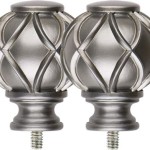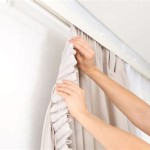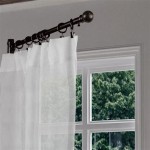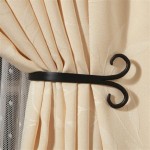Determining Ideal Walk-In Shower Curtain Length
Selecting the appropriate length for a walk-in shower curtain is crucial for both functionality and aesthetics. A properly sized curtain effectively contains water within the shower area, preventing slips and potential damage to the surrounding bathroom. Moreover, the length contributes significantly to the overall visual appeal of the space. The process for determining this optimal length requires careful consideration of various factors, including shower design, mounting height, and personal preferences regarding appearance and maintenance.
Unlike traditional shower stalls with raised thresholds, walk-in showers often feature level entryways, making water containment more challenging. Therefore, the shower curtain must be long enough to create an effective barrier without dragging excessively on the floor. This article will explore the key considerations for determining the ideal walk-in shower curtain length, ensuring both functionality and visual appeal are maximized.
Understanding Standard Shower Curtain Lengths
While custom options exist, shower curtains are typically manufactured in standard lengths, which serve as a reasonable starting point for determining appropriate dimensions. The most commonly available lengths are 70, 72, 78, 84, 96, 108 and sometimes even 120 inches. The standard 70 or 72-inch length is generally designed for traditional bathtub/shower combinations where the curtain rod is mounted at a standard height. These lengths are often insufficient for walk-in showers due to the absence of a tub wall to provide an initial barrier.
For walk-in showers, longer lengths are frequently required. The 78-inch and 84-inch options are often suitable for showers with slightly higher mounting points, providing more coverage below the rod and closer proximity to the floor. Extra-long curtains, such as the 96-inch, 108-inch and 120-inch varieties, are reserved for showers with particularly high ceilings or when a more dramatic, floor-grazing aesthetic is desired. Understanding these standard lengths provides a baseline for more precise measurement and selection.
It is imperative to remember that the listed length of a shower curtain typically refers to the fabric itself. The rings or hooks used to attach the curtain to the rod can add several inches to the overall hanging height. Therefore, this extra length has to be factored into your measurements to guarantee an accurate fit and avoid a curtain that is too short.
Accurately Measuring for a Walk-In Shower Curtain
Precise measurement is paramount to ensure the shower curtain adequately contains water and complements the bathroom decor. The first step involves determining the desired mounting height for the shower curtain rod. The rod should be positioned high enough to create a sense of spaciousness within the shower enclosure while also providing sufficient clearance for ease of movement.
Once the mounting height is established, measure the vertical distance from the shower curtain rod to the finished floor. This measurement represents the total length the shower curtain needs to cover. Note that finished floor refers to the uppermost surface of the bathroom floor, including tiles or any other covering. It is also worth measuring at several points along the shower, to account for the possibility of an uneven floor.
From this total length, consider the desired gap between the bottom of the curtain and the floor. A small gap, typically 1-2 inches, is recommended to promote air circulation and prevent the curtain from dragging or becoming excessively wet, reducing the risk of mildew. Subtarct this gap measurement from total length from rod to floor after which the resulting number will reflect the ideal shower curtain length.
It's important to account for the type of shower curtain rings or hooks being used. Different types of hardware will alter the overall hanging length. Measure the height added by the chosen hardware and factor that into the calculation to ensure the curtain hangs at the correct level. For example, if the hardware extends the curtain by 1 inch, that inch can be subtracted from the required curtain length.
Factors Influencing Curtain Length Choice
Beyond standard lengths and accurate measurements, several additional factors influence the optimal walk-in shower curtain length. The shower floor slope (or lack thereof), bathroom ventilation, and personal aesthetic preferences all play a significant role in the decision-making process.
The slope of the shower floor is particularly important in determining the required curtain length. If the shower floor slopes dramatically toward the drain, the curtain may need to be longer on the drain side to effectively contain water. Conversely, if the shower floor is relatively level, a more even curtain length will suffice. When floors are uneven, the shower curtain’s edge may need to barely brush the ground in the lowest area, while being an inch or two above the ground on the highest area of flooring.
Adequate bathroom ventilation is essential for preventing mildew growth. A shorter curtain with a larger gap at the bottom will promote better air circulation, aiding in the evaporation of moisture. However, this must be balanced against the need for adequate water containment. If the bathroom has poor ventilation, a longer curtain, coupled with regular cleaning and proper upkeep, can still be workable. Using a shower spray after each shower can help in controlling mold and mildew.
Personal aesthetic preferences also impact the ideal curtain length. A longer curtain that grazes the floor can create a more luxurious and elegant appearance. However, this look requires more frequent cleaning to prevent staining and mildew accumulation. Shorter curtains, on the other hand, offer a more casual and practical look. The choice ultimately depends on individual taste and the desired aesthetic for the bathroom.
Furthermore, the material of the shower curtain liner must be considered. A thicker, more substantial liner may require a slightly longer curtain to maintain a consistent look and ensure proper water containment. Also, consider the type of shower head. A rain shower head positioned directly above will require less water containment support from the shower curtain. A shower head aimed horizontally will require more water containment and potentially a wider shower curtain.
In summary, determining the ideal walk-in shower curtain length involves considering standard lengths, taking accurate measurements, and factoring in shower floor slope, bathroom ventilation, material of the shower curtain, and individual preferences. Using these guidelines, a homeowner can select a shower curtain that meets both functional and aesthetic expectations.

Standard Shower Curtain Size And The Best Choices

Guide To Shower Curtains Get Know Colors Sizes Materials More Parachute Blog

Choose The Correct Size Shower Curtain

Standard Shower Curtain Size And The Best Choices

At What Height Should A Shower Curtain Be Installed Gerwerken Crafts

Best Walk In Shower Enclosures A Guide Porcelanosa
Extra Long Shower Curtain My Favorites The Diy Playbook

Easy Access Walk In Shower With Curtain

3 Standard Shower Curtain Lengths To Know

These Shower Curtains Actually Fit Walk In Showers Keep Water Contained Long Cool Plastic Curtain








